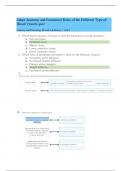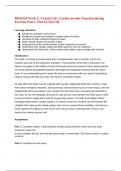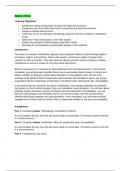KnowledgeBase
On this page, you find all documents, package deals, and flashcards offered by seller KnowledgeBase.
- 3981
- 0
- 631
Community
- Followers
- Following
172 Reviews received
4629 items

BIOS 255 Week 3 Concepts I The Cardiovascular System- Blood Vessels
BIOS 255 Week 3 Concepts I The Cardiovascular System- Blood Vessels
- Other
- • 49 pages •
BIOS 255 Week 3 Concepts I The Cardiovascular System- Blood Vessels

BIOS 255 Week 3 Concepts I The Cardiovascular System- Blood Vessels (Quiz)
1. Which major category of tissues is ideal for lining and covering structures? 2. Which form of membrane movement is ideal for the diffusion of gases? .........CONTI.............
- Exam (elaborations)
- • 3 pages •
1. Which major category of tissues is ideal for lining and covering structures? 2. Which form of membrane movement is ideal for the diffusion of gases? .........CONTI.............

BIOS 255 Week 3 Case Study; HYPOPROTEINEMIA
1. Describe all the constituents contained in plasma and their concentrations. 2. Explain the liver’s role in production of proteins. 3. Why would albumin be important in regulating pressure at the capillaries? 4. Explain the process of fluid movement at both the arterial and venous side of the capillary. 5. What can Betty do to improve her situation?
- Other
- • 5 pages •
1. Describe all the constituents contained in plasma and their concentrations. 2. Explain the liver’s role in production of proteins. 3. Why would albumin be important in regulating pressure at the capillaries? 4. Explain the process of fluid movement at both the arterial and venous side of the capillary. 5. What can Betty do to improve her situation?

BIOS 255 Week 3 Assignment; Case Study - Hypoproteinemia
BIOS 255 Week 3 Assignment; Case Study - Hypoproteinemia
- Other
- • 3 pages •
BIOS 255 Week 3 Assignment; Case Study - Hypoproteinemia

BIOS 255 Week 2 Virtual Lab; Cardiovascular Function during Exercise Part 1, Part II, Part III
Learning outcomes: ● Identify the chambers of the heart. ● Identify the location and function of valves within the heart. ● Describe the flow of blood through the heart. ● Define stroke volume and cardiac output. ● Understand how the cardiovascular system responds to exercise. ● Understand how cardiac output and blood pressure can be measured. ● Understand how heart rate, stroke volume and cardiac output change with exercise. Introduction: The heart is a strong muscular ...
- Other
- • 4 pages •
Learning outcomes: ● Identify the chambers of the heart. ● Identify the location and function of valves within the heart. ● Describe the flow of blood through the heart. ● Define stroke volume and cardiac output. ● Understand how the cardiovascular system responds to exercise. ● Understand how cardiac output and blood pressure can be measured. ● Understand how heart rate, stroke volume and cardiac output change with exercise. Introduction: The heart is a strong muscular ...

BIOS 255 Week 2 Discussion; The Heart (3 Versions).
Identify the chambers of the heart and their functions, the associated valves, and the names and general route of their associated great vessels.
- Other
- • 7 pages •
Identify the chambers of the heart and their functions, the associated valves, and the names and general route of their associated great vessels.

BIOS 255 Week 2 Assignment; Case Study; Heart
BIOS 255 Week 2 Assignment; Case Study; Heart
- Other
- • 3 pages •
BIOS 255 Week 2 Assignment; Case Study; Heart

BIOS 255 Week 2 Concepts I The Cardiovascular System- Heart
BIOS 255 Week 2 Concepts I The Cardiovascular System- Heart
- Other
- • 40 pages •
BIOS 255 Week 2 Concepts I The Cardiovascular System- Heart

BIOS 255 Week 2 Assignment; Case Study - Heart
1. What are the four valves found in the heart and where are they located? Give all names of each valve. 2. What is a mitral valve prolapse and what causes this in Marfan’s syndrome specifically? 3. What happens to blood flow (specifically) with a mitral valve prolapse (where would the blood back up to and why)? 4. If a person were to have a prolapse of the tricuspid valve, what specifically would happen to the flow of blood in that case? 5. Do you think Janet will ever play basketball aga...
- Other
- • 3 pages •
1. What are the four valves found in the heart and where are they located? Give all names of each valve. 2. What is a mitral valve prolapse and what causes this in Marfan’s syndrome specifically? 3. What happens to blood flow (specifically) with a mitral valve prolapse (where would the blood back up to and why)? 4. If a person were to have a prolapse of the tricuspid valve, what specifically would happen to the flow of blood in that case? 5. Do you think Janet will ever play basketball aga...

BIOS 255 Week 1 Virtual Lab; Hematology Part I, Part II, Part III
Learning Objectives: • Identify the cellular components of blood and state their functions. • Explain the role of the white blood cells in protecting the body from disease. • Analyze complete blood counts. • Learn how to use an automatic hematology analyzer and how to prepare a peripheral smear. • Name the 4 major blood types in the ABO system. • Explain the principles of blood typing using Eldon cards. • Describe Rh incompatibility and hemolytic disease of the newborn.
- Other
- • 5 pages •
Learning Objectives: • Identify the cellular components of blood and state their functions. • Explain the role of the white blood cells in protecting the body from disease. • Analyze complete blood counts. • Learn how to use an automatic hematology analyzer and how to prepare a peripheral smear. • Name the 4 major blood types in the ABO system. • Explain the principles of blood typing using Eldon cards. • Describe Rh incompatibility and hemolytic disease of the newborn.

NRNP 6531 Week 10 Knowledge Check; Musculoskeletal Conditions and Neurologic Conditions (Summer 2021).docx
BIO 220 Topic 1 Quiz
MATH 534 Week 7 Course Project, Final Part C; Regression and Correlation Analysis
NURS 6002 Week 3 Assignment; Part 3 - Strategies to Promote Integrity and Professional Ethics
NR 631 Week 6 Discussion; Planning and Scheduling (Initial Post, Responses)